|
Related FAQs: Sea
Urchins, Urchins 2, Urchins 3, Urchin Identification, Urchin Behavior, Urchin Compatibility, Urchin Selection, Urchin System, Urchin Feeding, Urchin Disease, Urchin Reproduction,
Related Articles: Echinoderms, An Introduction to the
Echinoderms: The Sea Stars, Sea Urchins, Sea Cucumbers and
More... By James W. Fatherree, M.Sc. Algae Control, Nutrient Control and
Export,
/A Diversity of Aquatic
Life
Some Spines
Now! Sea Urchins (and Sand Dollars), the Echinoids, Pt. 5
To:
Part 1, Part
2, Part 3,
Part 4, Part 6
|
|
|
By Bob Fenner
|
|
Family Temnopleuridae: Mespilia, Microcyphus.
| Mespilia globulus (Linnaeus 1758), the Blue
Tuxedo Urchin (Sphere Urchin of science). Eastern Indian Ocean to
western Pacific... in shallows amongst algae it grazes on. To three
inches in diameter. Needs hard substrates, shady areas. Can be kept
solitarily or in small groups. Eats mainly algae, including
corallines. Aquarium and N. Sulawesi pix. |
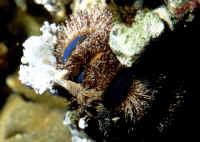
|
Bigger PIX:
The images in this table are linked
to large (desktop size) copies. Click on "framed" images
to go to the larger size. |
|
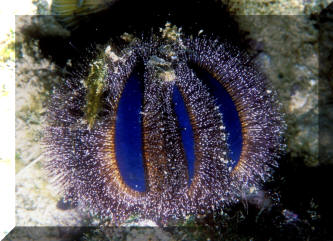
|
| Microcyphus rousseaui (Agassiz & Desor
1846), Rousseau's Sea Urchin. Western Indian Ocean; Red Sea to
eastern Africa. Shallow water (0-5 meters), mainly on upper reef
slope. Nocturnal, feeds on algae and sessile invertebrates. To
three inches in diameter. Red Sea image. |
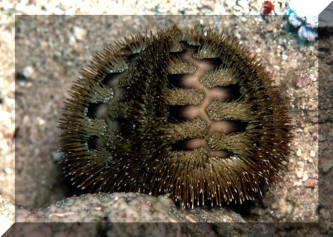
|
Family Toxopneustidae: Lytechinus, Toxopneustes,
Tripneustes.
| Lytechinus semituberculatus
(Agassiz & Desor 1846), Green Sea Urchin. To 6.4 inches in
diameter. Southeastern Pacific; Columbia to Peru and Galapagos
Islands. Decidedly yellow green in color. Common in rocky shores to
134 meters. Feeds principally on benthic algae. Galapagos pic. |
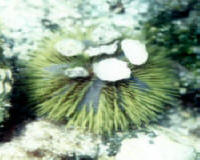
|
| Lytechinus variegatus (Leske 1778), the
Variegated Urchin. Family Toxopneustidae. Tropical West Atlantic;
Bermuda to Brazil, including the Gulf of Mexico. Lives in mud to
rocky substrates. Eats algae and animal based foods. Temp.: 22-28
C. A good choice for TWA biotopic presentations. |
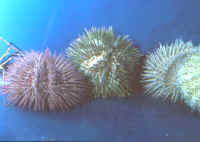
|
| Toxopneustes pileolus (Lamarck 1816), Flower Urchin.
Indo-Pacific. Very toxic to touch. To 12 cm. in diameter. At right, with
typical shells, debris stuck on with its tube-feet (in the Marquesas). |
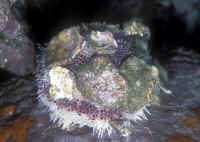
|
Bigger PIX:
The images in this table are linked
to large (desktop size) copies. Click on "framed" images
to go to the larger size. |
|
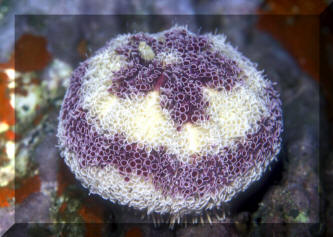
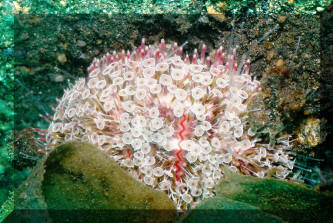
|
| Toxopneustes
roseus (A. Agassiz 1863), the Flower Urchin. Costa Rica
(Pacific side) 2011 |
%20MD.JPG)
|
Bigger PIX:
The images in this table are linked to large
(desktop size) copies. Click on "framed" images to go to
the larger size. |
|
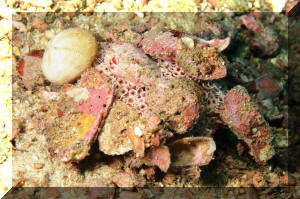
%20MD.JPG)
|
| Tripneustes depressus A. Agassiz
1863, the White Sea Urchin. To 12.5 inches in diameter. Eastern
Pacific; Southern California to Ecuador and Galapagos Islands.
Principally feeds on coralline algae. Galapagos pic. |
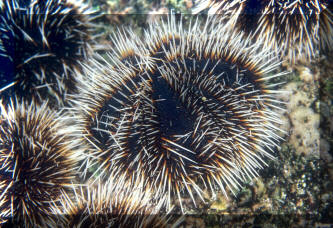
|
Bigger PIX:
The images in this table are linked
to large (desktop size) copies. Click on "framed" images
to go to the larger size. |
|
%20MD.JPG)
|
| Tripneustes gratilla (Linnaeus 1758), the
Priest-Hat or Collector Urchin. Family Toxopneustidae.
Indo-Pacific; Red Sea to Hawai'i. Toxic to the touch to sea
life. To about five inches in diameter overall. Mentioned so
hobbyists will avoid it. Shown: At right in Nuka Hiva, Marquesas,
Polynesia. Below: specimens in the Red Sea at night, Andaman Sea
and Hawai'i. |
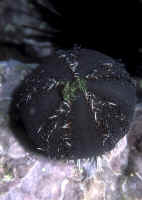 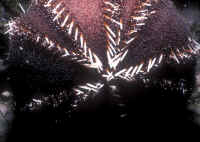
|
| Tripneustes ventricosus (Lamarck 1816), the
(West Indian) Sea Egg. Tropical East and West Atlantic coasts. Up
to eight inches in diameter. Juveniles inhabit rocks, adults moving
out to sand, grass beds. Cozumel at night and close up in the
Bahamas. |
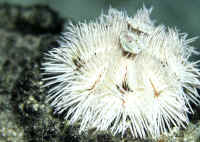 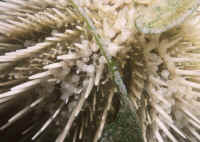
|
Bigger PIX:
The images in this table are linked
to large (desktop size) copies. Click on "framed" images
to go to the larger size. |
|
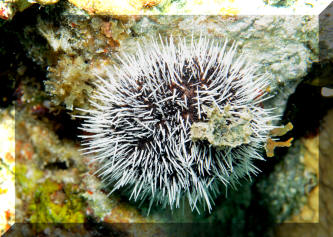
|
To:
Part 1, Part
2, Part 3,
Part 4, Part 6
|
|

